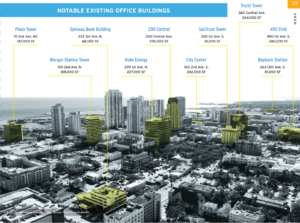Report: How St. Pete is meeting housing, office demands
St. Petersburg is experiencing unprecedented residential construction and low office vacancy rates as it continues to be among the top corporate relocation destinations; however, the city is facing headwinds in keeping up with the demand.
The hard data in the St. Petersburg Downtown Partnership’s 2023 Development Guide, which will be distributed during the Partnership’s Development Summit, taking place today (Tuesday, Feb. 28). The 48-page report presents informative insights weighing the pros and cons in the current market conditions in downtown.
The contributors in the report include St. Petersburg Innovation District Director Alison Barlow, Pinellas County Economic Development David Chawk, outgoing St. Petersburg Area Economic Development Corp. CEO J.P. DuBuque, Mack Feldman of Feldman Equities, Wendy Giffin of Cushman and Wakefield and others familiar with the city’s education offerings, its robust art scene, business climate and transit offerings.
Among the hot topics is the continuing housing crisis. The report states that despite significant residential construction, there’s a lack of housing inventory for working people such as teachers, firefighters, police officers, nurses and other public-facing professionals.
Although there is more housing in the works, there’s limited affordable options.
At the same time, office space has reached record low vacancy rates, creating a greater need for offices; however, it is challenging for developers to finance new development because of high land and construction costs.
Another ripple effect noted in the report is how these higher costs associated with development and existing real estate has resulted in St. Pete’s businesses grappling to pay higher rents.
The research was completed by Sarah Lindemuth at Meshsem Inc.
Housing: The dilemma of affordability
Certain events are attributing to the housing crisis, such as an influx of residents moving from other states, a recent and steep rise in homes purchased by investors, and the new housing supply not meeting the needs of the growing population, according to the report.
Between 2019 and 2021, residential purchases made by investors in St. Petersburg grew by 78%. During this same time, average rent in the city increased by more than 30%. In the first quarter of 2022, it spiked by 29%.
As of today, at St. Petersburg’s current average rental rate, renters would need to make at least $79,000 per year or receive $38/hour in a 40-hour weekly job. In reality, more than 77% of the city’s current renters have household incomes below $79,000.
However, there’s a silver lining – the number of new residential units (some incorporating affordable housing) is increasing. Unit growth in downtown between 2010-2014 and 2015-2019 exceeded 50%. Current projects under construction, as well as those proposed, are on pace to far exceed 50% growth for a third consecutive five-year span from 2020 through 2024.
Currently, there are over 8,700 existing residential units, 2,300 units under construction and over 3,900 proposed future units.
The report lists new proposed residential projects and developments coming online such as Sky St. Pete, Fairfield Apartments, Alexan 1700, Tuxedo Court, Kolter’s project for the Fit2Run site, Orange Station, 400 Central, Art House, Modera St. Petersburg and Saltaire.
Affordable housing: By the numbers
Downtown’s affordable housing inventory:
- 555 affordable units
- 63 workforce housing units
- 414 micro units (rents are lower as a result of smaller square footage)
Inventory outside of downtown:
- 1,052 affordable units
- 322 workforce housing units
Addressing the issue: Passed legislation, including changes to the city’s Tenant Bill of Rights that prohibit landlords from discriminating against renters based on their source of income, are helping protect tenants. The city also offers housing stipends.
Transportation: Fulfilling the missing link
The city has been a leader in micro-mobility through its bike and e-scooter sharing programs. More than 116,000 bike trips and 565,000 e-scooter trips occurred in the city from 2017 to May 2022.
St. Pete has a walkability score of 90% and a bike user score of 93%.
The report highlights different transit alternatives, such as the Central Avenue Trolley, which provides a connection from downtown St. Pete’s Bayshore to Beach Drive and St. Pete Beach, and the Cross Bay Ferry, linking St. Pete and Tampa via a 50-minute boat ride. St. Petersburg, the City of Tampa, Pinellas County and Hillsborough County dedicated funding in 2022 to continue the ferry service for three more years.
Pinellas Suncoast Transit Authority is also mentioned as it operates a fleet of 210 vehicles across more than 40 bus and trolley routes that provide more than 12.1 million rides per year, and debuted its newest service – the bus rapid transit system known as the SunRunner.
Office space: A growing need
St. Pete Central Business District (CBD) has a vacancy rate of 3.7%, half of what it was in 2020.
The city has 2.1 million square feet of commercial space with an average asking rent of $33.89 per square foot.

Existing major office towers in downtown St. Pete. Image: Downtown St. Petersburg Partnership.
Brokers are seeing high demand for small suites with immediate availability and short-term leases to test the need for office space. Small suites and collaborative workspaces in downtown established a launching for a number of these innovators (the majority of which are tech companies and startups). In 2022, downtown companies occupying nearly 50,000 square feet of co-working space moved to permanent space, the report reads.
The major tenants in the city include Dynasty Financial partners and ARK Invest, as well as the hospitals and colleges.
Workforce numbers
A national site selection study by The Boyd Company Inc. ranked St. Petersburg as a top 15 market for establishing headquarters due to the favorable income tax climate, positive demographic and business trend, housing market and additional measurements.
The city has five thriving industries: Life sciences, marine science, leisure and hospitality, finance and professional services and entrepreneurship.
These are the top growing jobs over the past five years:
- Over 2,309 jobs in leisure and hospitality sector
- Over 946 jobs in science sector
- Over 560 jobs in health care services
- Over 549 jobs in the government field
- Nearly 500 jobs in real estate and finance sectors
Currently, 33,100 people work in the downtown area.
The report also does a deep analysis of these sectors as well as the city’s arts and culture scene, neighborhoods, quality of life and sports sector.








Matthew Osborn
March 2, 2023at7:25 am
FYI – I believe the phot mis-identifies the City building as the SunTrust Tower.
Raymond V Tampa
March 1, 2023at1:24 am
Excellent article. It seems to be well researched and easily understood.